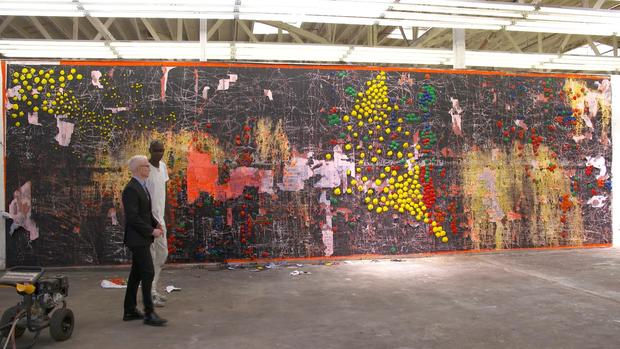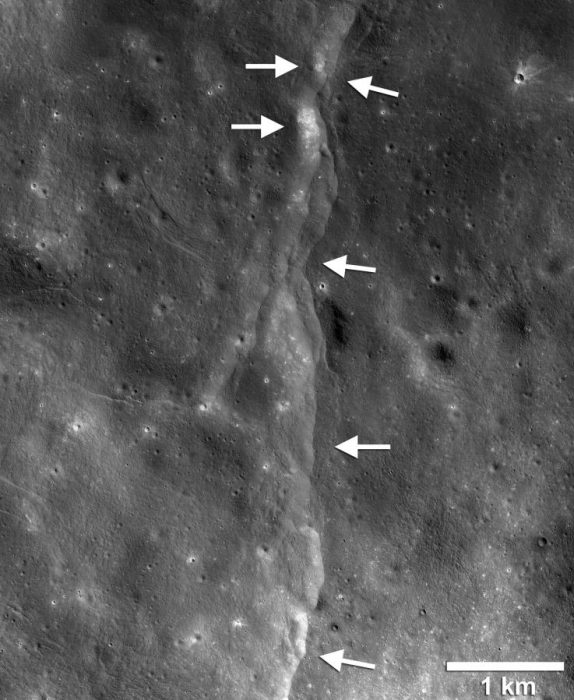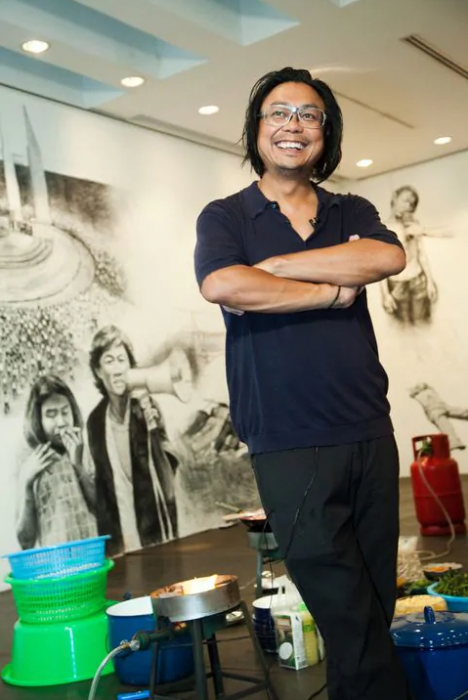ICYMI: Highlights from the week that was May 12 – May 18, 2019
No one can keep up with everything, so let us do it for you. We’ll gather the top Smithsonian stories from across the country and around the world each week so you’ll never be at a loss for conversation around the water cooler.
The moon is shrinking, the planet is trashed and we’re already talking about strip-mining in outer space. This was a week to chill out with free curry and fancy dresses.

Mark Bradford: The 60 Minutes Interview
Anderson Cooper profiles the artist who tackles complex social and political issues through abstract works
CBS News, May 12

Artist Mark Bradford shows Anderson Cooper one of his pieces (CBS News)
Mark Bradford is widely considered one of the most important and influential artists in America today. His abstract canvases, which often deal with complex social and political issues, hang in major museums around the world, and on the walls of big collectors and some small ones, like me. Bradford’s art may look like paintings, but there’s hardly any paint on them. They’re made out of layers and layers of paper, which he tears, glues, power washes and sands in a style all his own. When he began making art in his 30s, Bradford couldn’t afford expensive paint, so he started experimenting with endpapers, that are used for styling hair. He got the idea while working as a hair stylist in his mom’s beauty shop in South Los Angeles. He was broke, struggling, and didn’t sell his first painting until he was nearly 40. Read more and watch the full interview.
What the Smithsonian is unveiling for the 1st time ever during public gardens week
WJLA-ABC7, May 13
Museum Week kicked off Monday, but it’s also National Public Gardens week. The Smithsonian Gardens is an accredited museum, and it’s unveiling a project for the first time in its history.
One of the highlighted attractions is the parterre outside of the Smithsonian castle. Parterre is a French term meaning on or along the ground. It’s a breathtaking ornamental garden style that originated in the 16th-century Renaissance in Italy.
“We haven’t built new gardens. Added to the charm that we have here,” said Barbara Faust, director of the Smithsonian Gardens.
The Smithsonian Gardens is opening its first-ever Smithsonian-wide exhibition. Read more and watch the news clip.
Protect solar system from mining ‘gold rush’, say scientists
Proposal calls for wilderness protection as startup space miners look to the stars
The Guardian, May 12

Interplanetary mining, as envisaged in the film Alien (1979). Photograph: 20th Century Fox/Kobal/Rex/Shutterstock
Great swathes of the solar system should be preserved as official “space wilderness” to protect planets, moons and other heavenly bodies from rampant mining and other forms of industrial exploitation, scientists say.
The proposal calls for more than 85% of the solar system to be placed off-limits to human development, leaving little more than an eighth for space firms to mine for precious metals, minerals and other valuable materials.
While the limit would protect pristine worlds from the worst excesses of human activity, its primary goal is to ensure that humanity avoids a catastrophic future in which all of the resources within its reach are permanently used up.
“If we don’t think about this now, we will go ahead as we always have, and in a few hundred years we will face an extreme crisis, much worse than we have on Earth now,” said Martin Elvis, a senior astrophysicist at the Smithsonian Astrophysical Observatory in Cambridge, Massachusetts. “Once you’ve exploited the solar system, there’s nowhere left to go.” Read more from the Guardian.
The moon is shrinking and it’s causing “moonquakes” on the lunar surface
Newsweek, May 13

One of the thrust faults discovered by NASA’s Lunar Reconnaissance Orbiter.
LROC NAC FRAME M190844037LR; NASA/GSFC/ARIZONA STATE UNIVERSITY/SMITHSONIAN
In 2010, scientists discovered that our moon had been shrinking as its interior cooled down—and may still be getting smaller. Using images from NASA’s Lunar Reconnaissance Orbiter (LRO), researchers discovered cliffs in the lunar crust that had formed relatively recently, geologically speaking: They could be just 100 million years old.
The findings suggested that these “cliffs,” or thrust faults, had formed as a result of tectonic activity related to the moon contracting in size as it cooled.
As the moon cools and gets smaller, its crust becomes brittle and breaks up: a bit like what happens to a grape as it dries out to become a raisin. Those breaks in the surface produce thrust faults. Since it began operation a decade ago, over 3,500 of these faults have been identified by the LRO. Those that appear brighter indicate freshly exposed lunar rock, suggesting an event like a “moonquake,” which is an earthquake that takes place on the moon. Read more from Newsweek.
A Reimagined Spy Museum in Washington Doesn’t Flinch from the Darker Side
Built for $162 million, the museum features flashy interactive exhibits but also grapples with intelligence failures, out-of-control surveillance and torture.
The New York Times, May 6
Read the entire exhibition review: A Reimagined Spy Museum in Washington Doesnt Flinch From the Darker Side – The New York Times – 5.6.19
Every Object Tells a Story: Interview with curator Alexandra Cunningham Cameron
Pin-Up (Architecture magazine)

Curator of contemporary design at the Cooper Hewitt, Smithsonian Design Museum Alexandra Cunningham Cameron photographed by Josep Fonti for PIN–UP.
In the rarified world of collectible design, one would be hard-pressed to find anyone who hasn’t heard of or worked with Alexandra Cunningham Cameron. A literature graduate, the prolific 38-year-old Miami native began her professional career in 2007 at Design Miami, only two years after Art Basel Miami Beach’s sister fair first opened its doors to high-profile collectors. Since then she’s worked as Design Miami’s creative director, as a public-design consultant for the Miami Design District, as an independent curator and critic in the U.S. and Europe, and as the editor in chief of the arts publication Miami Rail. In September 2018, Cunningham Cameron took on a slightly less peripatetic role as curator of contemporary design and the Edward and Helen Hintz Secretarial Scholar at the storied Cooper Hewitt, Smithsonian Design Museum — the United States’ national museum for design where her first exhibition will debut in February 2020. On the heels of the opening of the institution’s first Design Triennial, PIN–UP caught up with Cunningham Cameron to discuss the culture of curating. On the heels of the opening of the institution’s first Design Triennial, PIN–UP caught up with Cunningham Cameron to discuss the culture of curating. Read the entire interview.
Lisa Sasaki, Director of the Smithsonian Asian Pacific American Center Discusses Inaugural Annual Event
The Hype Magazine, May 13

Smithsonian Asian Pacific American Center, a migratory museum that shares Asian Pacific American (APA) history, art, and culture through innovative community-focused experiences, announced its inaugural annual event, The Party. Featuring special performances by hip hop and R&B phenom Jay Park and iconic jazz band Hiroshima, The Party takes place May 18, 2019, in Los Angeles. The VIP reception will be hosted by Harry Shum Jr. Tickets are available via Smithsonianapa.org.
“The Party will celebrate the indelible contributions of Asian Pacific Americans to the American experience,” said Lisa Sasaki, the director of the Smithsonian Asian Pacific American Center. “From music to technology, sports to entertainment, these modern history makers inspire Americans of every ethnicity, religion and socioeconomic background by demolishing barriers and challenging timeworn stereotypes with their talents, perseverance, and ingenuity.” Read the complete interview.
The Met Will Turn Down Sackler Money Amid Fury Over the Opioid Crisis
The New York Times, May 15
Read the entire article:The Met Will Turn Down Sackler Money Amid Fury Over the Opioid Crisis – The New York Times – 5.15.19
Artist Rirkrit Tiravanija is serving free curry at his Hirshhorn installation. We asked him to explain why.
The Washington Post, May 16

Rirkrit Tiravanija believes you can conquer fear of the other through food and art. (Courtesy of 100 Tonson Gallery, Bangkok/Courtesy of 100 Tonson Gallery, Bangkok)
Does contemporary art make you hungry? Then you’re going to love the Hirshhorn’s new exhibit, “Rirkrit Tiravanija: Who’s Afraid of Red, Yellow, and Green.” The installation, which opens Friday, serves up three colors of Thai curry to lunchtime visitors, who can dine while watching area art students sketch images of political protests on the gallery walls. (Visitors can even assist with the drawing if they’d like.) Read more from The Washington Post.
The Crazy Rich Asians “Cinderella” Dress Will Soon Be at the American History Museum
The dress, worn by Constance Wu, will join Dorothy’s slippers and the Batmobile at the museum.
Washingtonian, May 16

Constance Wu in Marchesa as seen in Crazy Rich Asians. Photograph by Sanja Bucko.
The National Museum of American History will soon have one of Constance Wu‘s dresses from the blockbuster 2018 rom-com Crazy Rich Asians. Marchesa is donating the light blue tulle gown, which was originally from its fall 2016 collection. This weekend in LA, the dress will be on display for the first time; eventually it will make its way to DC to join the Batmobile, Dorothy’s ruby red slippers, and a handmaid’s costume as items that the museum has selected to illustrate American history through film and television. Read more from Washingtonian.
Cooper Hewitt’s Design Triennial considers our alliance with the Earth
Projects range from animating a white rhino to creating an environmentally friendly “burial suit”
The Art Newspaper, May 17
Read the entire article: Cooper Hewitt’s Design Triennial considers our alliance with the Earth – The Art Newspaper – 5.17.19
Why won’t the Smithsonian agree to honor all Native American veterans in its new memorial?
The Hill, May 18

© Getty Images
The Smithsonian Institution is about make a huge mistake by creating a Native American Veterans Memorial that will omit certain Native American veterans.
The Smithsonian plans to construct this memorial on the National Mall, with groundbreaking scheduled for September 2019. It’s a wonderful idea — one that is long overdue.
Congress passed legislation in 1994 allowing the national monument to be built, and it took 24 years — until June 2018 — for the Smithsonian to agree to a memorial design. The design, which can be found on the Smithsonian website, consists of a series of concentric circles, which the Smithsonian says represent a “Warrior’s Circle of Honor.” The designer is Native American veteran Harvey Pratt, and it is a handsome design, indeed. Read more from The Hill.
Posted: 22 May 2019
-
Categories:
Astrophysical Observatory , Cooper Hewitt Museum , Hirshhorn Museum , News & Announcements








